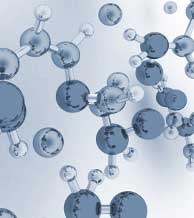p-HYDROXYBENZOATE HYDROXYLASE from Microorganism
HBH-311
| Appearance: | Yellowish amorphous powder, lyophilized | ||
|---|---|---|---|
| Activity: | GradeⅢ 20U/mg-solid or more (containing approx. 40% of stabilizers) |
||
| Contaminant: | NADPH oxidase ≤1.0×10⁻¹% | ||
| Stabilizers: | Sugars, FAD | ||
| Stability: | Stable at -20°C for at least One year (Fig.1) |
|---|---|
| Molecular weight : | 55,000~60,000 |
| Michaelis constants: | 2.0×10⁻⁵M (p-Hydroxybenzoate), 4.0×10⁻⁵M (NADPH) |
| Structure: | One mol of FAD per mol of enzyme |
| Inhibitors : | Ag⁺, Hg⁺⁺, PCMB, SDS |
| Optimum pH : | 7.7-7.9(Fig.3) |
| Optimum temperature : | 35°C(Fig.4) |
| pH Stability : | pH 5.0-7.5 (25°C, 72hr)(Fig.5) |
| Thermal stability : | below 40°C (pH 6.0, 15min)(Fig.6) |
| Substrate specificity : | (Table 1) |
| Effect of various chemicals: | (Table 2) |
APPLICATIONS
This enzyme is useful for enzymatic determination of choline esterase when coupled with protocatechuate 3, 4-dioxygenase (PCO-302).
ASSAY
Principle:
p-hydroxybenzoate hydroxylase
p-Hydroxybenzoate+NADPH+H⁺+O₂ ► Protocatechuate+NADP⁺+H₂O
The disappearance of NADPH is measured at 340nm by spectrophotometry.
Unit definition:
One unit causes the oxidation of one micromole of NADPH per minute under the conditions described below.
Method:
| A. Tris-malate buffer, pH 8.2: | 50mM [Dissolve 3.03g of Tris (M.W=121.14) in ca.300ml of H₂O and, after adjusting the pH to 8.2 at 25°C with 1.0M maleic acid, fill up to 500ml with H₂O.] |
|---|---|
| B. p-hydroxybenzoate solution: | 5.0mM [80mg p-hydroxybenzoate (Na salt)/100ml of buffer solution (A)] (Should be prepared fresh) |
| C. FAD solution: | 0.2mM [19mg FAD・Na₂/100ml or buffer solution (A)](Should be prepared fresh) |
| D. NADPH solution: | 3.0mM [272mg NADPH・Na₄・4H₂O/100ml of buffer solution (A)](Should be prepared fresh) |
| F. Enzyme diluent: | 50mM K-phosphate buffer, pH 6.0 containing 0.2% BSA |
Procedure
| Concentration in assay mixture | |
|---|---|
| Tris-malate buffer | 49 mM |
| p-Hydroxybenzoate | 0.49mM |
| FAD | 20 µM |
| NADPH |
0.30mM |
1. Prepare the following working solution (10 tests) in a brownish bottle and store on ice.
21.0 ml Buffer solution (A)
3.0 ml Substrate solution (B)
3.0 ml FAD solution (C)
3.0 ml NADPH solution (D)
2. Pipette 3.0ml of working solution into a cuvette (d=1.0cm) and equilibrate at 37°C for about 5 minutes.
3. Add 0.05ml of the enzyme solution* and mix by gentle inversion.
4. Record the decrease in optical density at 340nm against water for 3 to 4 minutes in a spectrophotometer thermostated at 37°C and calculate the ΔOD per minute from 1.5 to 3 minutes portion of the curve (ΔOD test). At the same time, measure the blank rate (ΔOD blank) by using the same method as the test except that the enzyme diluent (E) is added instead of enzyme solution.
* Dissolve the enzyme preparation in ice-cold enzyme diluent (E) (1.0mg/ml or more) and dilute to 0.2-0.6 U/ml with the same buffer, immediately before assay.
Calculation
Activity can be calculated by using the following formula :

ΔOD/min (ΔOD test−ΔOD blank ) ×Vt × df
Volume activity (U/ml) = =ΔOD/min×9.8×df
6.22×1.0×Vs
Weight activity (U/mg)=(U/ml)×1/C
- Vt
- : Total volume (3.05ml)
- Vs
- : Sample volume (0.05ml)
- 6.22
- : Millimolar extinction coefficient of NADPH (㎠/micromole)
- 1.0
- : Light path length (cm)
- df
- : Dilution factor
- C
- : Enzyme concentration (c mg/ml)
REFERENCES
- H.Shoun and K.Arima; Protein, Nucleic acid and Enzyme, 25, 820, (1980).
- K.Yano and K.Arima; Agric.Biol.Chem., 33, 689 (1969).
- K.Hosokawa and R.Y.Stanier; J.Biol.Chem., 241, 2453 (1966).
| Substrate (0.5mM) | Relative activity(%) | Substrate (0.5mM) | Relative activity(%) |
|---|---|---|---|
| p-Hydroxybenzoic acid | 100 | Protocatechuic acid | 3.3 |
| Methyl-p-hydroxybenzoic acid | <0.05 | ß-Resorcylic acid | 4.5 |
| Ethyl-p-hydroxybenzoic acid | <0.05 |
Gentisic acid | <0.05 |
| n-Propyl-p-hydroxybenzoic acid | <0.05 |
p-Chlorobenzoic acid | <0.05 |
| m-Hydroxybenzoic acid | <0.05 | p-Aminobenzoic acid | 0.12 |
| o-Hydroxybenzoic acid | <0.05 |
| Chemical | Concn.(mM) | Residual activity(%) |
Chemical | Concn.(mM) | Residual activity(%) |
|---|---|---|---|---|---|
| None | − | 100 | MIA | 1.0 | 91 |
| Metal salt | 1.0 | PCMB | 1.0 | 3.7 | |
| CoCl₂ | 106 |
NaN₃ | 1.0 | 97 | |
| ZnCl₂ |
94 | NaF | 1.0 | 96 |
|
| CuSO₄ |
103 | o-Phenanthroline | 1.0 | 95 | |
| AgNO₃ | 0 | α,α′-Dipyridyl | 1.0 | 90 | |
| MgSO₄ | 107 | EDTA | 5.0 | 96 |
|
| BaCl₂ | 107 | Borate | 50 | 104 | |
| FeCl₃ | 106 | Tween 20 | 0.1% | 91 | |
| MnCl₂ | 90 | Brij 35 | 0.1% | 101 | |
| NiCl₂ | 104 | Span 20 | 0.1% | 94 | |
| CaCl₂ | 97 | Triton X-100 | 0.1% | 97 | |
| SnCl₂ | 102 |
Na-cholate | 0.1% | 88 |
|
| HgCl₂ | 1.1 | SDS | 0.05% | 34 | |
| CrCl₂ | 93 |
||||
| CdCl₂ | 104 | ||||
| FeSO₄ | 90 |
MIA, Monoiodoacetate; PCMB, p-Chloromercuribenzoate; EDTA, Ethylenediaminetetraacetate; SDS, Sodium dodecyl sulfate.

To get a quote, contact us at info@toyobousa.com, or INQUIRY.
